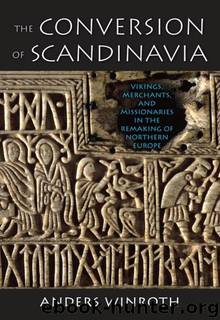The Conversion of Scandinavia by Winroth Anders

Author:Winroth, Anders [Winroth, Anders]
Language: eng
Format: azw3, epub
ISBN: 9780300178098
Publisher: Yale University Press
Published: 2012-01-23T16:00:00+00:00
Fig. 21 The former consul Gaius Silius Aulus Caecina Largus took up residence in Trier (today in western Germany) in 14 C.E. as military commander of the Roman province Germania superior. He probably brought with him these exquisite silver cups, decorated with scenes from Homer's Iliad and marked with the name “Silius.” The cups somehow came to be deposited in a grave in Denmark, illustrating how the borders between the Roman Empire and the “barbarian” lands to its north were porous and did not prevent Mediterranean artifacts and cultural ideas from traveling to Scandinavia. Photo: Lennart Larsen, by courtesy of Nationalmuseet, Copenhagen.
With their illustrations from the Iliad, the Hoby cups carried an ideology from the shores of the Mediterranean to the shores of the Baltic Sea. This does not mean that those ideas were necessarily understood “correctly” by Scandinavians admiring the cups. Occasionally, however, archeological finds permit us to glimpse non-Christian Greco-Roman religious ideas that have traveled to the north. Several Scandinavian graves, for example, contain gold objects that appear to have been put in the mouth of the dead person. One of them is the exceptionally rich woman's grave in Himlingøje, on Seeland, in Denmark. She was buried with a piece of gold in her mouth and a Roman coin (struck for Emperor Titus) at her side. Archeologists have interpreted this as Charon's wages, which Romans and Greeks usually put into the mouth of their dead. Charon would then ferry them over the Styx and Acheron Rivers to the land of the dead. Since coins did not circulate as money in Scandinavia, other valuables were used instead.35 If this interpretation is correct, the finds demonstrate that Greco-Roman religious practices traveled to Scandinavia. Christian practices later traveled a similar route.
Religious Ambiguities in Archeology
All over northern Europe, archeologists have found early medieval graves that they cannot confidently categorize as either Christian or pagan. I shall argue that it is meaningless to ask whether such graves are Christian or pagan, as they simply represent different stages in the assimilation of Christian practices.
Archeologists look at six or more criteria to determine whether a grave is Christian or pagan. First, Christian burials were almost without exception inhumations, that is, the body was not burned before it was buried. Cremation was taboo among early medieval Christians. For instance, around 780 Charlemagne legislated the death penalty for those burning their dead.36 He did so because cremation was intimately associated with paganism. This does not necessarily mean, however, that every inhumation is Christian, for pagans also sometimes buried their dead without burning them. This is testimony to shifting fashions, some of which may in fact have been influenced by Christian practices. Archeologists have discovered Scandinavian inhumations from as early as the sixth century.37 Among the several buried chieftains in the great grave fields of Vendel and Valsgärde, in central Sweden, some were cremated, some were not.38 This seems to have had little to do with their religion, since these persons according to all other criteria were pagan.
A
Download
The Conversion of Scandinavia by Winroth Anders.epub
This site does not store any files on its server. We only index and link to content provided by other sites. Please contact the content providers to delete copyright contents if any and email us, we'll remove relevant links or contents immediately.
Joan of Arc by Mary Gordon(3281)
Victory over the Darkness by Neil T. Anderson(2398)
The Gnostic Gospels by Pagels Elaine(2047)
Devil, The by Almond Philip C(1913)
The Nativity by Geza Vermes(1858)
The Psychedelic Gospels: The Secret History of Hallucinogens in Christianity by Jerry B. Brown(1833)
Going Clear by Lawrence Wright(1586)
Going Clear: Scientology, Hollywood, and the Prison of Belief by Lawrence Wright(1580)
Barking to the Choir by Gregory Boyle(1512)
A TIME TO KEEP SILENCE by Patrick Leigh Fermor(1507)
Old Testament History by John H. Sailhamer(1501)
Augustine: Conversions to Confessions by Robin Lane Fox(1479)
A History of the Franks by Gregory of Tours(1404)
The Knights Templar by Sean Martin(1403)
A Prophet with Honor by William C. Martin(1380)
The Bible Doesn't Say That by Dr. Joel M. Hoffman(1377)
by Christianity & Islam(1354)
The Amish by Steven M. Nolt(1257)
The Time Traveler's Guide to Medieval England by Ian Mortimer(1224)
